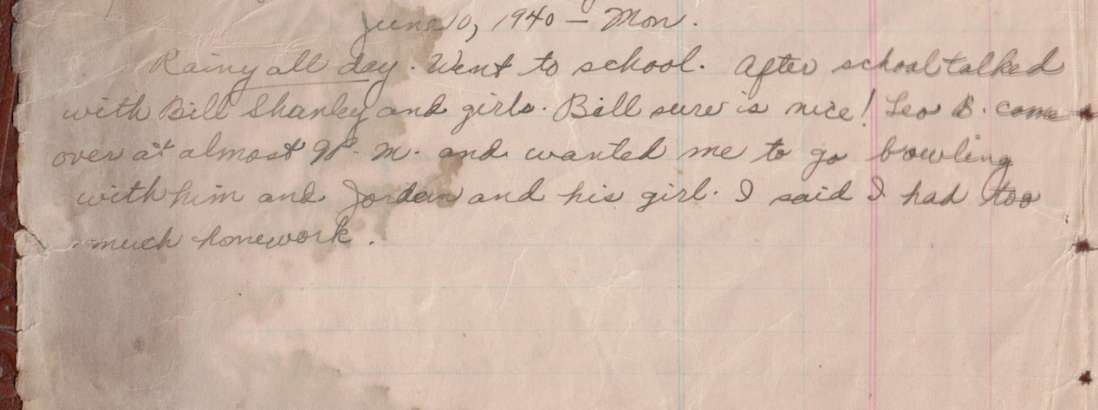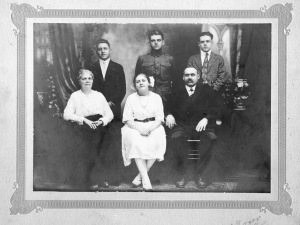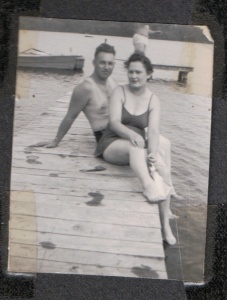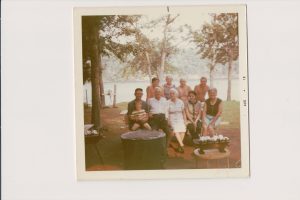This week’s prompt is Heirloom. This topic could not have come at a better/worse time. Family heirlooms have been very much on my mind this past week and I’m having a hard time even thinking about writing this blog post without tearing up. To me, heirlooms come in all shapes and sizes. Some are valuable and are worthy of lugging on Antiques Roadshow. Others have nothing but sentimental value.
One inherited item I cherish is my grandmother’s diary. Marie Elizabeth O’Connell was born 28 May 1924 in Rhode Island. She passed away when I was less than two years old, so this diary means so much to me. I only have a few pages; I don’t know what became of the rest. The pages are from a large book, 11×14, and are yellowed and brittle. The pages I have are from 1939 and 1940 and she would have been 15 and 16 years old when she wrote them. The diary reads like you might expect from a teenager of that era. Or really, any era. Lots of talk of boys, school, spending time with her friends, and dancing. She was taking shorthand, and used that for the bits she didn’t want anyone else to be able to read.
A few times she mentions my grandfather, Bill Shanley, whom she would marry 7 years later. Who says nice guys never win?
Just a typical teenaged girl – impressed by a classy car even when the guy is not so hot!
I just love these snippets into the life of a grandmother I never had the chance to know.
A lot of my ‘heirlooms’ relate to cooking…
My grandmother, Nancy Lewonis, was known for her baking. She made the best baked goods. She lived across the street from me while I was growing up, and I would love it when the phone would ring, with her on the other end, telling me to come over to get a loaf of raisin bread that had just come out of the oven. My mother would cut thick slices and I would hover over the toaster, waiting for my piece, ready to slather butter across every bit of surface area. Yum! I’m getting hungry just thinking about it. Nancy Sheffield Lloyd, or Mimi, as she was known to her grandchildren, was born on 2 August, 1923 in Easthampton, Massachusetts. Perhaps she would have been a stellar baker anyway (as so many of her generation were), but I wonder if her mother-in-law’s skills spurred her on to become even better. Nancy married Bernard Lewonis on 23 October 1942. Gramps’ mother was a pie-baker extraordinaire. Well, according to Gramps, anyway. He would often tell the stories of the many pies of all varieties his mother would bake on a Saturday.
Mimi made delicious pies with perfect crusts, but I loved her breads and muffins best. She passed away in 1997, and while Gramps did not take up baking her breads and pies, he did master Apple Crisp. I’ll never forget the first time he made it for a dessert following a family dinner. He surprised us all! After Gramps died in 2015, I inherited Mimi’s baking pans. They were thin aluminum, ancient, misshapen, scratched and dented, but baked like nothing you can buy today. There were two muffin pans and two loaf pans. I used the loaf pans the most. Quick breads and even meatloaf baked beautifully. And, they were so easy to clean. Nothing stuck. Knowing how much I loved them, my mother bought me a square aluminum baking pan a few years ago for Christmas. I like it and use it often, but it is just not the same. The last time I used one of the loaf pans was to make a loaf of cranberry bread for Thanksgiving 2017.
Mimi collected Franciscan Apple dinnerware and had every imaginable serving dish and accessory. Candle holders, glasses, teacups, butter dish, gravy boat, EVERYTHING! The dishes would come out of the china cabinet for Christmas, Thanksgiving, and other family celebrations. The appleware was as much a part of each gathering as the family and food. After Gramps passed and the house was being sold, the tableware was divided. I took just a few pieces to round out my eclectic collection of dishes.

Over the years, I accumulated a hodgepodge of dishes that had belonged to other family members. A few pieces of Corelle to remember my Grandmother Hawkins, Pfaltzgraff bowls to remember my late Aunt Judy, etc. Every time I used one of my aunt’s bowls, I’d remember her loading up the bowl with pasta, me protesting that it was way too much, and her telling me to eat what I could. Every time I used a dish that had belonged to someone else, I was reminded of meals shared with the original owner. The Corelle makes me think of frozen fish sticks (yuck!) and lumpy mashed potatoes.

Of course, some heirlooms aren’t just sentimental and have monetary value as well. Years before my Grandmother Hawkins died, she passed her aunt’s ring on to me. Bertha Mae Brayton was born 23 June 1879. She was my grandmother’s father’s older sister. Her father, Charles Brayton, was a farmer. Her brothers were also farmers and Bertha may have been the first in her family to attend college. After finishing college, she worked as a bookkeeper in Providence, Rhode Island until 1912, when she was appointed Postmistress of the Post Office in Hope, Rhode Island. My grandmother said her Aunt Bertha was a formidable woman who didn’t take any guff from anyone. She never married. When she was in her 40’s, she decided to buy herself a diamond ring. It’s a stunning vintage ring in a setting with gold flowers and onyx accents. I don’t wear the ring often, but always get compliments when I do.
I still have my precious diary pages and family jewelry, but no longer have my dishes or bakeware. Unfortunately, last week I lost 99% of the contents of my kitchen when a car missed a turn whilst fleeing the police, and crashed through my kitchen. I do still have one Franciscan apple glass and a saucer, now chipped. While I may have lost the physical objects, I still have my memories. And isn’t it the memories attached that make an heirloom so valuable?















